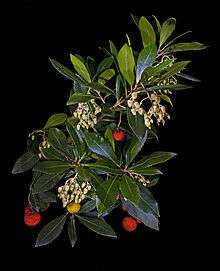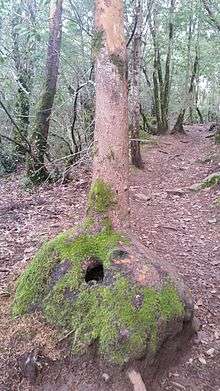Arbutus
| Arbutus | |
|---|---|
 | |
| Arbutus unedo | |
| Scientific classification | |
| Kingdom: | Plantae |
| (unranked): | Angiosperms |
| (unranked): | Eudicots |
| (unranked): | Asterids |
| Order: | Ericales |
| Family: | Ericaceae |
| Subfamily: | Arbutoideae |
| Genus: | Arbutus L.[1] |
| Type species | |
| Arbutus unedo L. 1753 | |
| Species | |
|
See text. | |
Arbutus is a genus of 11 accepted species[2] of flowering plants in the family Ericaceae, native to warm temperate regions of the Mediterranean, western Europe, and North America. The name is borrowed from Latin, where it referred to A. unedo.[3]
Description
Arbutus are small trees or shrubs with red flaking bark and edible red berries.[4] Fruit development is delayed for about five months after pollination, so that flowers appear while the previous year's fruit are ripening.[4]
Common names

Members of the genus are called madrones or madronas in the United States, from the Spanish name madroño (strawberry tree). In Canada—in British Columbia, where the species is common—arbutus is commonly used or, rarely and locally, "tick tree."[5][6] All refer to the same species, Arbutus menziesii, native to the Pacific Northwest and Northern California regions. It is Canada's only native broadleaved evergreen tree. Some species in the genera Epigaea, Arctostaphylos and Gaultheria were formerly classified in Arbutus. As a result of its past classification, Epigaea repens (mayflower) has an alternative common name of "trailing arbutus".
Species
A study published in 2001 which analyzed ribosomal DNA from Arbutus and related genera suggests that Arbutus is paraphyletic and the Mediterranean Basin species of Arbutus are more closely related to Arctostaphylos, Arctous, Comarostaphylis, Ornithostaphylos and Xylococcus than to the western North American species of Arbutus, and that the split between the two groups of species occurred at the Paleogene/Neogene boundary.[7]
Old World
- Arbutus andrachne L. – Greek Strawberry Tree (Southeastern Europe and southwestern Asia)
- Arbutus canariensis Duhamel – Canary Madrone (Canary Islands)
- Arbutus pavarii Pampan. (Libya)
- Arbutus unedo L. – Strawberry Tree (Mediterranean Basin, western France, and western Ireland)[8]
New World
- Arbutus arizonica (A.Gray) Sarg. – Arizona Madrone (New Mexico, Arizona and western Mexico south to Jalisco)
- Arbutus glandulosa Mart. & Galeotti (Central and southern Mexico)
- Arbutus madrensis M. González - western Mexico
- Arbutus menziesii Pursh – Pacific Madrone (West coast of North America from southern British Columbia to central California, on the west slopes of the Sierra Nevada and Pacific Coast Range mountains)
- Arbutus occidentalis McVaugh & Rosatti - western Mexico
- Arbutus peninsularis Rose & Goldman (Baja California Peninsula of Mexico)
- Arbutus tessellata (Mexico)[9]
- Arbutus xalapensis Kunth (syn. A. texana) – Texas Madrone (Texas, New Mexico and northeastern Mexico)[8]
Hybrids
- Arbutus 'Marina' – Marina Strawberry Tree, unknown parentage although Arbutus unedo variety rubra is undoubtedly one of the parents. It is also likely that either or both of A. canariensis and A. andrachne conferred not only structural size but leaf size and smoothness of bark. The parent species likely experienced different blooming times, as the hybrid blooms nearly continuously and sets copious fruit.
- Arbutus × andrachnoides Link (A. andrachne × A. unedo)[8]
Formerly placed here
- Arctostaphylos tomentosa (Pursh) Lindl. (as A. tomentosa Pursh)
- Arctostaphylos uva-ursi (L.) Spreng. (as A. uva-ursi L.)
- Comarostaphylis discolor (Hook.) Diggs (as A. discolor Hook.)
- Gaultheria phillyreifolia (Pers.) Sleumer (as A. phillyreifolia Pers.)[8]
Natural history
Arbutus species are used as food plants by some Lepidoptera species including emperor moth, Pavonia pavonia.
Uses and symbolism

Several species are widely cultivated as ornamental plants outside of their natural ranges, though cultivation is often difficult due to their intolerance of root disturbance. The hybrid Arbutus 'Marina' is much more adaptable and thrives under garden conditions.
The Arbutus unedo tree makes up part of the coat of arms (El oso y el madroño, The Bear and the Strawberry Tree) of the city of Madrid, Spain. In the center of the city (Puerta del Sol) there is a statue of a bear eating the fruit of the madroño tree. The image appears on city crests, taxi cabs, man-hole covers, and other city infrastructure.
The Arbutus was important to the Straits Salish people of Vancouver Island, who used arbutus bark and leaves to create medicines for colds, stomach problems, and tuberculosis, and as the basis for contraceptives. The tree also figured into certain myths of the Straits Salish.[10]
The fruit is edible but has minimal flavour and is not widely eaten. In Portugal, the fruit is sometimes distilled (legally or not) into a potent brandy known as medronho. In Madrid, the fruit is distilled into madroño, a sweet, fruity liqueur.
Arbutus is a great fuelwood tree since it burns hot and long. Many Pacific Northwest states in the United States use the wood of A. menziesii primarily as a heat source, as the wood holds no value in the production of homes since it doesn't grow in straight timbers.
My love's an arbutus is the title of a poem by the Irish writer Alfred Perceval Graves (1846–1931), set to music by his compatriot Charles Villiers Stanford (1852–1924)
Cultural significance
According to the Straits Salish, an anthropomorphic form of pitch would go fishing, but return to shore before it got too hot. One day he was too late getting back to shore and melted from the heat and several anthropomorphic trees rushed to get him - the first was Douglas Fir, who took most of the pitch, the Grand Fir received a small portion, and the Madrone received none - which is why they say it still has no pitch.
Also, according to the Great Flood legends of several bands in the northwest, the madrone helped people survive by providing an anchor on top of a mountain. Because of this the Saanich people do not burn madrone out of thanks for saving them.[11]
-

Arbutus menziesii—full tree
-

Arbutus menziesii—flowers
-

Arbutus menziesii—bark
-

Arbutus unedo—Corsica
-

Arbutus unedo—leaves and fruit
-

Arbutus menziesii — trunk
-

Photographed in Los Altos, CA, Redwood Nature Preserve
References
- ↑ "Genus: Arbutus L.". Germplasm Resources Information Network. United States Department of Agriculture. 2003-06-04. Retrieved 2012-04-17.
- ↑ "The plant list, Arbutus". Royal Botanic Garden, Kew.
- ↑ Quattrocchi, Umberto (2000). CRC World Dictionary of Plant Names. I: A-C. CRC Press. p. 182. ISBN 978-0-8493-2675-2.
- 1 2 Mabberley, D.J. 1997. The plant book: A portable dictionary of the vascular plants. Cambridge University Press, Cambridge.
- ↑ Pojar, Jim; Andy MacKinnon (1994). Plants of Coastal British Columbia. Vancouver: Lone Pine Publishing. p. 49. ISBN 978-1-55105-042-3.
- ↑ Francis, Daniel (2000). The Encyclopedia of British Columbia (2nd ed.). Madeira Park, BC: Harbour Publishing. p. 20. ISBN 978-1-55017-200-3.
- ↑ Hileman, Lena C.; Vasey, Michael C.; Parker, V.Thomas (2001). "Phylogeny and Biogeography of the Arbutoideae (Ericaceae): Implications for the Madrean-Tethyan Hypothesis". Systematic Botany. 26 (1): 131–143. JSTOR 2666660.
- 1 2 3 4 "GRIN Species Records of Arbutus". Germplasm Resources Information Network. United States Department of Agriculture. Retrieved 2012-04-17.
- ↑ Paul D. Sørensen 1987. Arbutus tessellata (Ericaceae), new from Mexico Brittonia, 39(2):263-267.
- ↑ Pojar and MacKinnon, 49
- ↑ Plants of the Pacific Northwest Coast: Washington, Oregon, British Columbia & Alaska, Written by Paul Alaback, ISBN 978-1-55105-530-5
| Wikisource has the text of the 1905 New International Encyclopedia article Arbutus. |
- Hileman, Lena C., Vasey, Michael C., & Thomas Parker, V. 2001. Phylogeny and Biogeography of the Arbutoideae (Ericaceae): Implications for the Madrean-Tethyan Hypothesis. Systematic Botany 26 (1): 131–143.
External links
| Wikispecies has information related to: Arbutus |
| Wikimedia Commons has media related to Arbutus. |